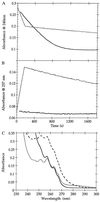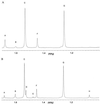A point mutation leads to altered product specificity in beta-lactamase catalysis
- PMID: 9012802
- PMCID: PMC19531
- DOI: 10.1073/pnas.94.2.443
A point mutation leads to altered product specificity in beta-lactamase catalysis
Abstract
beta-Lactamases are the primary cause of beta-lactam antibiotic resistance in many pathogenic organisms. The beta-lactamase catalytic mechanism has been shown to involve a covalent acyl-enzyme. Examination of the structure of the class A beta-lactamase from Bacillus licheniformis suggested that replacement of Asn-170 by leucine would disrupt the deacylation reaction by displacing the hydrolytic water molecule. When N170L beta-lactamase was reacted with penicillins, a novel product was formed. We postulate that with leucine at position 170 the acyl-enzyme undergoes deacylation by an intramolecular rearrangement (rather than hydrolysis) to form a thiazolidine-oxazolinone as the initial product. The oxazolinone subsequently undergoes rapid breakdown leading to the formation of N-phenylacetylglycine and N-formylpenicillamine. This appears to be the first reported case where a point mutation leads to a change in enzyme mechanism resulting in a substantially altered product, effectively changing the product specificity of beta-lactamase into that of D-Ala-D-Ala-carboxypeptidase interacting with benzylpenicillin.
Figures


Similar articles
-
Peptidase activity of beta-lactamases.Biochem J. 1999 Jul 15;341 ( Pt 2)(Pt 2):409-13. Biochem J. 1999. PMID: 10393100 Free PMC article.
-
Site-directed mutagenesis of beta-lactamase leading to accumulation of a catalytic intermediate.Biochemistry. 1991 Nov 5;30(44):10783-7. doi: 10.1021/bi00108a025. Biochemistry. 1991. PMID: 1681903
-
Structural and biochemical evidence that a TEM-1 beta-lactamase N170G active site mutant acts via substrate-assisted catalysis.J Biol Chem. 2009 Nov 27;284(48):33703-12. doi: 10.1074/jbc.M109.053819. Epub 2009 Oct 6. J Biol Chem. 2009. PMID: 19812041 Free PMC article.
-
Three decades of the class A beta-lactamase acyl-enzyme.Curr Protein Pept Sci. 2009 Oct;10(5):401-7. doi: 10.2174/138920309789351967. Curr Protein Pept Sci. 2009. PMID: 19538154 Free PMC article. Review.
-
Structure, Function of Serine and Metallo-β-lactamases and their Inhibitors.Curr Protein Pept Sci. 2018;19(2):130-144. doi: 10.2174/0929866524666170724160623. Curr Protein Pept Sci. 2018. PMID: 28745223 Review.
Cited by
-
X-ray evidence of a native state with increased compactness populated by tryptophan-less B. licheniformis β-lactamase.Protein Sci. 2012 Jul;21(7):964-76. doi: 10.1002/pro.2076. Epub 2012 May 31. Protein Sci. 2012. PMID: 22496053 Free PMC article.
-
Equilibrium partially folded states of B. licheniformis-lactamase.Eur Biophys J. 2019 May;48(4):341-348. doi: 10.1007/s00249-019-01361-8. Epub 2019 Mar 30. Eur Biophys J. 2019. PMID: 30929094
-
Chemical tags and beyond: Live-cell protein labeling technologies for modern optical imaging.Smart Mol. 2023 Aug 28;1(2):e20230002. doi: 10.1002/smo.20230002. eCollection 2023 Sep. Smart Mol. 2023. PMID: 40626074 Free PMC article. Review.
-
A large displacement of the SXN motif of Cys115-modified penicillin-binding protein 5 from Escherichia coli.Biochem J. 2005 Nov 15;392(Pt 1):55-63. doi: 10.1042/BJ20050449. Biochem J. 2005. PMID: 16038617 Free PMC article.
-
AmpC and AmpH, proteins related to the class C beta-lactamases, bind penicillin and contribute to the normal morphology of Escherichia coli.J Bacteriol. 1997 Oct;179(19):6112-21. doi: 10.1128/jb.179.19.6112-6121.1997. J Bacteriol. 1997. PMID: 9324260 Free PMC article.
References
-
- Neu H C. Science. 1992;257:1064–1073. - PubMed
-
- Herzberg O, Moult J. Science. 1987;236:694–701. - PubMed
-
- Moews P C, Knox J R, Dideberg O, Charlier P, Frere J M. Protein Struct Funct Genet. 1990;7:156–171. - PubMed
-
- Strynadka N C J, Adachi H, Jensen S E, Johns K, Sielecki A, Betzel C, Sutoh K, James M N J. Nature (London) 1992;359:700–705. - PubMed
Publication types
MeSH terms
Substances
LinkOut - more resources
Full Text Sources
Other Literature Sources

